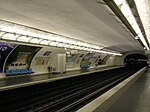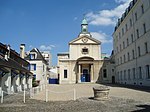Cours de Vincennes
Streets in the 12th arrondissement of ParisStreets in the 20th arrondissement of Paris
The Cours de Vincennes (formerly Avenue de Vincennes) is a street in Paris, linking place de la Nation to porte de Vincennes. It forms a major artery and serves as the border between the city's 12th and 20th arrondissements. It was built before 1860 and forms the start of Route nationale 34.
Excerpt from the Wikipedia article Cours de Vincennes (License: CC BY-SA 3.0, Authors).Cours de Vincennes
Cours de Vincennes, Paris 12th Arrondissement (Paris)
Geographical coordinates (GPS) Address Phone number Website Nearby Places Show on map
Geographical coordinates (GPS)
| Latitude | Longitude |
|---|---|
| N 48.8473 ° | E 2.4048 ° |
Address
Giant Paris 12
Cours de Vincennes
75012 Paris, 12th Arrondissement (Paris)
Ile-de-France, France
Open on Google Maps










